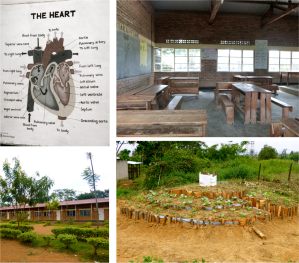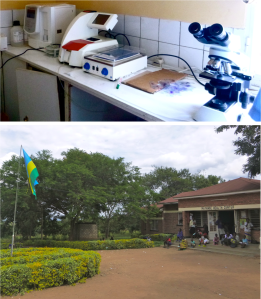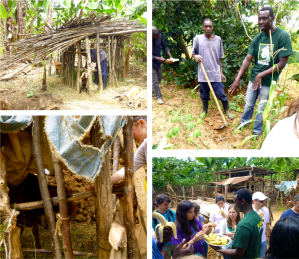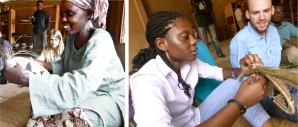[We just got our internet a few days ago, and I’ve been aiming to post about our first week here in Kigali, and I will soon!! But today and yesterday were something special, so I think I’ll start there. I don’t think I’ve completely worked through this weekend myself yet, but I’ll do my best to summarize what we experienced.]
Yesterday was dedicated to a community tour of Rwanda’s Millennium Village. The village of Mayange has a population of over 24,000. Since the 1950s this village has been severely affected by genocide, where even husbands may have killed their own wife or child based on race. When refugees and returnees came back to Rwanda after the genocide, the government deforested the Mayange area so they could settle there. While it was once fertile with abundant rainfall, the area became characterized by soil erosion, decreased rainfall, drought, and famine. The Millennium Village Project is currently being implemented in 14 locations in 10 countries, approaching rural development by addressing many overlapping areas of extreme poverty [http://www.millenniumvillages.org/the-villages].
Our first stop in the village was a genocide memorial site. I did not take any pictures there, but I know that what I heard, saw, and felt in that place will never be forgotten…
The memorial was an old catholic church. Through the aluminum ceiling of the veranda, the sunlight shone through a mass of bullet holes. Looking on to the metal-bar front door, a large hole was blown away by a grenade, which also left the brick floor below shattered. Walking into the sanctuary, we saw a mass of clothes piled on the pews and front stage. These remnants represented the 11,000 Tutsis massacred there. Across the alter, a once pure-white linen was stained red, and several weapons that were used in the attack were laid on top, including a wooden cross. We continued downstairs and entered a bright white room. This room had the greatest effect on me. A large glass case was in the center and a casket was housed beneath the glass floor. Without being too graphic, I don’t think I can fully describe this room. The glass case held gripping evidence of how several of the victims were killed. Still, the most impactful was hearing the unfathomable suffering experienced by the woman who was buried in the casket. Next, we went outside and into an underground ‘tomb’, filled with the victim’s remains stacked neatly on shelves. Last, we saw the grave of the nun who tried to save thousands of people by hiding them in the church. Hearing about her conviction, bravery, and strength was in a way a glimmer of light in the midst of pure darkness. Obviously, it’s impossible to come close to truly comprehending what it was like that night in the church, and I can’t give justice to the memorial in one paragraph. But overall, I was shown a glimpse of the country’s pain during the genocide that was now a launching point for understanding where the country is today and where it is headed.
After the memorial, we visited the Mayange B Primary School. The school has been renovated in the past few years and additional buildings have been built. For 904 students, the school has only 13 teachers and 13 class rooms (of which only 7 have electricity). Still, the school has begun to truly thrive, where more than 90% of students in the area now attend school. I loved seeing the signs of encouragement to the students scattered around the campus, leftover physics notes on a primary school blackboard, and practical farming skills built in to the curriculum.

Top left: one of many instructional paintings on the outside walls of the school. Top right: typical classroom. Bottom left: Outside of one of the new school buildings. Bottom right: garden used at the school for both teaching and harvesting.
Next, we visited the Mayange Health Center. In the span of only one year, the center went from seeing 50 to over 4500 patients due to increased awareness and improved interventions. Also, after evaluating the village through research and surveys, it became clear that 94% of the population could not afford healthcare or insurance. Changes were made to adjust the cost of healthcare based on household wealth so that in 2007 a jump from 38% to 90% health insurance enrollment was made! Still, with all of the exciting development occurring in the health care center, there were at least 50 patients at the center when we were there with only three nurses working (no doctors). Overall, it gave us some insight into the excellent progress but remaining room for growth in rural healthcare in Rwanda.

Top: Laboratory equipment used to analyze patient’s blood. Bottom: Outside of health center, where patients waited to see one of three nurses.
After the health center we visited a local farmer’s home, where we took a tour of his fields filled with bananas, cassava, coffee, giant avacados, plantains, and just about every other fruit we could hope for. Before the initiation of the Millenium project, widespread famine accounted for 30% of children under 5 years of age suffering from malnutrition. The local farmer’s home was a true representation of agricultural transformation! At the end, we were treated to the most delicious bananas I’ve ever eaten, which we then fed to the eager cows.

Top left: local farmer and his goats housed in the fruit field. Top right: learning how to plant a cassava tree. Bottom right: delicious fresh-picked bananas! Bottom left: Feeding my banana to the cows.
We ate a delicious lunch at a local restaurant and then traveled to a cooperative, or handicraft association. The room was filled with beautiful woven goods that were made by women in the village. We even learned how to weave a basket from one of the women who worked there! While I pretend to be Pinterest-savvy sometimes, it became very clear that my “craft” skills were nil compared to these women :). What was most incredible about the cooperative was the reconciliation it represented in Mayange. Women with family members who were both perpetrators, victims, and refugees came together, put aside their anger, pain, and differences to work together.
Last, we traveled to a neighborhood where the homes were constructed by the government for resettlers in an effort of reconciliation. The houses were occupied by survivors, perpetrators, and returnees. We were greeted from the bus by traditional song and dance by the children in the community. They were such impressive and talented kids! After a few songs, we heard from two men in the village: the first was a genocide perpetrator and the second was a survivor. The first man’s story opened our eyes to the lies they were made to believe that caused them to commit such horrific acts. But, what was most incredible was his testimony of redemption and grace. While they were in jail, they were visited by pastors and the veil of lies over many of their eyes was removed. They realized the sin in their hearts and repented, knowing they deserved death. After nine years in jail, they were allowed to confess their crimes, be forgiven, and return to society. Talk about true, undeserved, radical GRACE! I cannot imagine a more real representation of Christ’s redeeming power. The second man was a Tutsi genocide survivor. At only 11 years of age, his parents were murdered and he fled to Burundi. When he was able to return, he had every human right to hate those who killed his family members. But again, a transformation took place in his heart and he was able to forgive.
After the memorial in the morning, my heart was heavy and thoughts of “how could that have happened?” and “would I be able to forgive if my family member were killed?” were running through my head. It seemed like the deaths caused by the genocide in Rwanda could never, ever be reconciled. But Rwanda has truly been transformed: I heard first-hand stories of reconciliation and genuine forgiveness, and saw perpetrators and survivors now living side-by-side, with no fear of each other–even to the point where they trust their once enemy with their children.
After hearing from the men, we shared a taste of banana wine and then the dancers taught us how to do their dance! It was a fun end to an emotionally arduous day, and it was great to interact with the kiddos. They got a kick out of us muzungu trying to dance…engineering muzungu at that ;).
Finally, this morning at church I felt a sense of closure about all that we took in yesterday. It was “women church”, where women lead many of the songs and a woman gave the sermon. Her topic: forgiveness. She spoke from Genesis 50:15-21, the story of Joseph forgiving his brothers. After incredible struggles and tribulation (all rooting in his brothers’ betrayal), Joseph not only had mercy and forgave, but he was able to shower them with love. The woman’s testimony of transformation was incredible in itself, but the take-home message was simple: if we cannot forgive, we cannot release the power of Heaven. When we forgive those who have hurt or rejected us, God can fulfill his divine, wonderful plan in our lives through our struggles. In every way, Rwanda’s history is a perfect example of this. Through horrible pain and suffering, grace and forgiveness have paved the way for a radically transformed people.


Jami,
Thanks for sharing! Such an amazing account of God’s perfect Grace! Sounds like the “Africa Experience” is starting off Awesome! It will be life changing I’m sure:)
Love, Lisa
Lisa! Indeed it has been great. Keeping y’all in Boise close to my heart! Miss you my friend :)
Jami, Grandpa and I read this together..I am moved to tears. It makes me wonder again at the grace of God that has been so freely given to us. We pray, and we are anticipating hearing from you again…soon?? We love you so much!!
Hi Grandma! I would love to talk soon. Maybe we can work around the time difference and skype or call sometime :) Love you both!